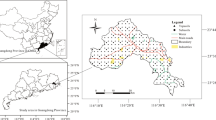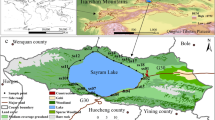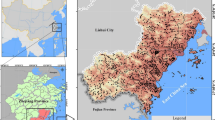Abstract
Purpose
The study aimed to investigate the geochemical baseline concentrations (GBCs), pollution status, ecological risk, human health risk, sources, and source-specific risk of potentially toxic elements (PTEs) in soils around the Han River Reservoir (HRR).
Materials and methods
Topsoil and subsoil samples collected from HRR were analyzed for PTEs (As, Cd, Cr, Cu, Hg, Ni, Pb, Zn). The cumulative frequency distribution (CFD) curves were established to estimate the GBCs. The geoaccumulation index (Igeo), modified potential ecological risk index (NIRI), and human health risk assessment (HHRA) were committed to identifying pollution and risk characteristics. Absolute principal component score-multi-liner regression (APCS-MLR) and positive matrix factorization (PMF) models were applied to determine the sources and to quantitatively identify source-specific risks.
Results and discussion
The GBCs in HRR were significantly different from the background values of Hubei. The mean concentrations of Cd, Cr, Cu, Pb, and Zn were 1.6, 1.0, 1.2, 1.1, and 1.1 times higher than the GBCs, respectively. Cd and Hg were the primary contributors to ecological risk. As and Cr were the major elements affecting health risks, while those for humans were within acceptable limits. The main sources were atmospheric deposition (As, Pb), agricultural activities (Cd), soil parent material (Cr, Cu, and Ni), industrial activities (Zn), and mixed sources consisting of soil parent material and agricultural activities (Hg). Among them, agricultural activities, soil parent material, and atmospheric deposition were the main factors affecting ecological and human health.
Conclusions
The accumulation and contamination of PTEs were influenced by a combination of anthropogenic and natural factors. As, Cd, Cr, and Hg should be given special attention due to their contamination risks.








Similar content being viewed by others
Data availability
Not applicable.
References
Al-Shannag M, Al-Qodah Z, Bani-Melhem K et al (2015) Heavy metal ions removal from metal plating wastewater using electrocoagulation: Kinetic study and process performance. Chem Eng J 260:749–756. https://doi.org/10.1016/j.cej.2014.09.035
Ali H, Khan E, Ilahi I (2019) Environmental chemistry and ecotoxicology of hazardous heavy metals: Environmental persistence, toxicity, and bioaccumulation. J Chem. https://doi.org/10.1155/2019/6730305
Beata L, Cezary K, Jaroslaw W (2018) Ambient geochemical baselines for trace elements in Chernozems—approximation of geochemical soil transformation in an agricultural area. Environ Monit Assess 191:19. https://doi.org/10.1007/s10661-018-7133-1
Bindraban PS, Dimkpa CO, Pandey R (2020) Exploring phosphorus fertilizers and fertilization strategies for improved human and environmental health. Biol Fertil Soils 56:299–317. https://doi.org/10.1007/s00374-019-01430-2
Cai L, Huang L, Zhou Y et al (2010) Heavy metal concentrations of agricultural soils and vegetables from Dongguan, Guangdong. J Geogr Sci 20:121–134. https://doi.org/10.1007/s11442-010-0121-1
Cao X, Li W, Song S et al (2022) Source apportionment and risk assessment of soil heavy metals around a key drinking water source area in northern China: multivariate statistical analysis approach. Environ Geochem Health. https://doi.org/10.1007/s10653-022-01251-7
Carrillo KC, Rodríguez-Romero A, Tovar-Sánchez A et al (2022) Geochemical baseline establishment, contamination level and ecological risk assessment of metals and As in the Limoncocha lagoon sediments, Ecuadorian Amazon region. J Soils Sediments 22:293–315. https://doi.org/10.1007/s11368-021-03084-w
Chen L, Wang J, Beiyuan J et al (2022) Environmental and health risk assessment of potentially toxic trace elements in soils near uranium (U) mines: A global meta-analysis. Sci Total Environ 816:151556. https://doi.org/10.1016/j.scitotenv.2021.151556
Cherry S, Banfield J, Quimby WF (1996) An evaluation of a non-parametric method of estimating semi-variograms of isotropic spatial processes. J Appl Stat 23:435–449. https://doi.org/10.1080/02664769624170
Chormare R, Kumar MA (2022) Environmental health and risk assessment metrics with special mention to biotransfer, bioaccumulation and biomagnification of environmental pollutants. Chemosphere 134836. https://doi.org/10.1016/j.chemosphere.2022.134836
Christensen ER, Steinnes E, Eggen OA (2018) Anthropogenic and geogenic mass input of trace elements to moss and natural surface soil in Norway. Sci Total Environ 613–614:371–378. https://doi.org/10.1016/j.scitotenv.2017.09.094
Chu Y, Liu S, Wang F et al (2017) Estimation of heavy metal-contaminated soils’ mechanical characteristics using electrical resistivity. Environ Sci Pollut Res 24:13561–13575. https://doi.org/10.1007/s11356-017-8718-x
CNEMC (1990) Soil element background value in China. China Environmental Science Press, Beijing, Beijing
Cogliano VJ, Baan R, Straif K et al (2010) Preventable exposures associated with human cancers. J Natl Cancer Inst 103:1827–1839. https://doi.org/10.1093/jnci/djr483
Dai Y, Shangguan W (2019) Dataset of soil properties for land surface modeling over China. National Tibetan Plateau Data Center. https://doi.org/10.11888/Soil.tpdc.270281.
Dong H, Lin Z, Wan X, Feng L (2017) Risk assessment for the mercury polluted site near a pesticide plant in Changsha, Hunan, China. Chemosphere 169:333–341. https://doi.org/10.1016/j.chemosphere.2016.11.084
Du D, Wang C, Du X et al (2017) Distance-gradient-based variogram and Kriging to evaluate cobalt-rich crust deposits on seamounts. Ore Geol Rev 84:218–227. https://doi.org/10.1016/j.oregeorev.2016.12.028
Elbehiry F, Elbasiouny H, Cappuyns V, Brevik EC (2021) Available concentrations of some potentially toxic and emerging contaminants in different soil orders in Egypt and assessment of soil pollution. J Soils Sediments 21:3645–3662. https://doi.org/10.1007/s11368-021-03021-x
Faisal M, Wu Z, Wang H et al (2022) Assessment and source apportionment of water-soluble heavy metals in road dust of Zhengzhou, China. Environ Sci Pollut Res. https://doi.org/10.1007/s11356-022-20666-4
Förstner U, Ahlf W, Calmano W, Kersten M (1990) Sediment criteria development. In: Heling D, Rothe P, Förstner U, Stoffers P (eds) Sediments and Environmental Geochemistry: Selected Aspects and Case Histories. Springer, Berlin Heidelberg, Berlin, Heidelberg, pp 311–338
Grezzi G, Ayuso RA, De Vivo B et al (2011) Lead isotopes in soils and groundwaters as tracers of the impact of human activities on the surface environment: The Domizio-Flegreo Littoral (Italy) case study. J Geochemical Explor 109:51–58. https://doi.org/10.1016/j.gexplo.2010.09.012
Guang X, Chen J, Qu M et al (2022) Effects of mining on the potentially toxic elements in the surrounding soils in China: A meta-analysis. Sci Total Environ 821:153562. https://doi.org/10.1016/j.scitotenv.2022.153562
Guo G, Li K, Lei M (2022) Accumulation, environmental risk characteristics and associated driving mechanisms of potential toxicity elements in roadside soils across China. Sci Total Environ 835:155342. https://doi.org/10.1016/j.scitotenv.2022.155342
Guo GH, Wang YT, Zhang DG, Lei M (2021) Source-specific ecological and health risks of potentially toxic elements in agricultural soils in Southern Yunnan Province and associated uncertainty analysis. J Hazard Mater 417.https://doi.org/10.1016/j.jhazmat.2021.126144
Guo X, Zheng C-G, Xu M-H (2004) Characterization of arsenic emissions from a coal-fired power plant. Energy Fuels 18:1822–1826. https://doi.org/10.1021/ef049921b
Haghnazar H, Johannesson KH, González-Pinzón R et al (2022) Groundwater geochemistry, quality, and pollution of the largest lake basin in the Middle East: Comparison of PMF and PCA-MLR receptor models and application of the source-oriented HHRA approach. Chemosphere 288:132489. https://doi.org/10.1016/j.chemosphere.2021.132489
Haji Gholizadeh M, Melesse AM, Reddi L (2016) Water quality assessment and apportionment of pollution sources using APCS-MLR and PMF receptor modeling techniques in three major rivers of South Florida. Sci Total Environ 566–567:1552–1567. https://doi.org/10.1016/j.scitotenv.2016.06.046
Hakanson L (1980) An ecological risk index for aquatic pollution control.a sedimentological approach. Water Res 14:975–1001. https://doi.org/10.1016/0043-1354(80)90143-8
Han J, Liang L, Zhu Y et al (2022) Heavy metal ( loid ) s in farmland soils on the Karst Plateau , Southwest China : An integrated analysis of geochemical baselines , source apportionment , and associated health risk. 1689–1703.https://doi.org/10.1002/ldr.4257
He Y, Han Z, Wu F et al (2021) Spatial distribution and environmental risk of arsenic and antimony in soil around an antimony smelter of Qinglong County. Bull Environ Contam Toxicol 107:1043–1052. https://doi.org/10.1007/s00128-021-03118-6
Hegde S, Kumar G, Engle C et al (2022) Technological progress in the US catfish industry. J WORLD Aquac Soc 53:367–383. https://doi.org/10.1111/jwas.12877
Hu B, Zhou Y, Jiang Y et al (2020) Spatio-temporal variation and source changes of potentially toxic elements in soil on a typical plain of the Yangtze River Delta, China (2002–2012). J Environ Manage 271:110943. https://doi.org/10.1016/j.jenvman.2020.110943
Huang B, Yuan Z, Li D et al (2020) Effects of soil particle size on the adsorption, distribution, and migration behaviors of heavy metal(loid)s in soil: a review. Environ Sci Process Impacts 22:1596–1615. https://doi.org/10.1039/D0EM00189A
Huang Y, Wang L, Wang W et al (2019) Current status of agricultural soil pollution by heavy metals in China: a meta-analysis. Sci Total Environ 651:3034–3042. https://doi.org/10.1016/j.scitotenv.2018.10.185
IARC (2011) List of classifications—IARC monographs on the identification of carcinogenic hazards to humans. https://monographs.iarc.who.int/list-of-classifications. Accessed 12 Jun 2022
ISSAS (2010) China Soil Science Data Center. http://vdb3.soil.csdb.cn/. Accessed 5 Aug 2022
Jiang Y, Chao S, Liu J et al (2017) Source apportionment and health risk assessment of heavy metals in soil for a township in Jiangsu Province, China. Chemosphere 168:1658–1668. https://doi.org/10.1016/j.chemosphere.2016.11.088
Jin Z, Lv J (2021) Evaluating source-oriented human health risk of potentially toxic elements: a new exploration of multiple age groups division. Sci Total Environ 787:147502. https://doi.org/10.1016/j.scitotenv.2021.147502
Kebonye NM, Eze PN, John K et al (2021) Self-organizing map artificial neural networks and sequential Gaussian simulation technique for mapping potentially toxic element hotspots in polluted mining soils. J Geochemical Explor 222:106680. https://doi.org/10.1016/j.gexplo.2020.106680
Levitan DM, Schreiber ME, Seal RR et al (2014) Developing protocols for geochemical baseline studies: An example from the Coles Hill uranium deposit, Virginia, USA. Appl Geochem 43:88–100. https://doi.org/10.1016/j.apgeochem.2014.02.007
Li C, Sun L, Jia J et al (2016a) Risk assessment of water pollution sources based on an integrated k-means clustering and set pair analysis method in the region of Shiyan, China. Sci Total Environ 557–558:307–316. https://doi.org/10.1016/j.scitotenv.2016.03.069
Li Q, Wei Y-N, Dong Y (2016b) Coupling analysis of China’s urbanization and carbon emissions: example from Hubei Province. Nat Hazards 81:1333–1348. https://doi.org/10.1007/s11069-015-2135-6
Liu X, Song Q, Tang Y et al (2013) Human health risk assessment of heavy metals in soil–vegetable system: A multi-medium analysis. Sci Total Environ 463–464:530–540. https://doi.org/10.1016/j.scitotenv.2013.06.064
Liu Z, Fei Y, Shi H et al (2022) Prediction of high-risk areas of soil heavy metal pollution with multiple factors on a large scale in industrial agglomeration areas. Sci Total Environ 808:151874. https://doi.org/10.1016/j.scitotenv.2021.151874
Loska K, Wiechuła D, Korus I (2004) Metal contamination of farming soils affected by industry. Environ Int 30:159–165. https://doi.org/10.1016/S0160-4120(03)00157-0
Lu S, Teng Y, Wang Y et al (2015) Research on the ecological risk of heavy metals in the soil around a Pb–Zn mine in the Huize County, China. Chinese J Geochemistry 34:540–549. https://doi.org/10.1007/s11631-015-0062-6
Lu Y, Jia C, Zhang G et al (2016) Spatial distribution and source of potential toxic elements (PTEs) in urban soils of Guangzhou. China Environ Earth Sci 75:329. https://doi.org/10.1007/s12665-015-5190-0
Maroufpoor S, Bozorg-Haddad O, Chu X (2019) Geostatistics: principles and methods. In: Samui P, Tien Bui D, Chakraborty S, Deo RC (eds) Handbook of Probabilistic Models. Butterworth-Heinemann, pp 229–242
Men C, Liu R, Xu L et al (2020) Source-specific ecological risk analysis and critical source identification of heavy metals in road dust in Beijing, China. J Hazard Mater 388:121763. https://doi.org/10.1016/j.jhazmat.2019.121763
MEP (2015) Solid Waste–Determination of metals–inductively coupled plasma mass spectrometry (ICP-MS). In: Ministry of Environmental Protection of China. http://english.mee.gov.cn/Resources/standards/Solid_Waste/Method_Standard5/201605/t20160512_337581.shtml. Accessed 12 Jun 2022
MEP (2014a) Soil and sedimen—determination of mercury, arsenic, selenium, bismuth, antimony - Microwave dissolution/Atomic Fluorescence Spectrometry. In: Ministry of Environmental Protection of China. http://english.mee.gov.cn/Resources/standards/Soil/Method_Standard4/201605/t20160506_337320.shtml. Accessed 12 Jun 2022
MEP (2014b) Technical guidelines for risk assessment of contaminated sites. In: Ministry of Environmental Protection of China. https://english.mee.gov.cn/Resources/standards/Soil/Method_Standard4/201605/t20160506_337324.shtml. Accessed 12 Jun 2022
MEP, MLR (2014) The report on national general survey on soil contamination. In: Ministry of Environmental Protection of China and Ministry of Land Resources of China.. http://www.gov.cn/foot/2014-04/17/content_2661768.htm. Accessed 12 Jun 2022
MLR (2014) Specification of multi-purpose regional geochemical survey(1:250000) (DZ/T 0258–2014). In: Ministry of Land Resources of China. http://www.nrsis.org.cn/mnr_kfs/file/read/e4db05d15f1c84cd77cbf82db03b848f. Accessed 12 Jun 2022
Muller G (1969) Index of geoaccumulation in sediments of the Rhine river. GeoJournal 2:108–118
Niu S, Gao L, Wang X (2019) Characterization of contamination levels of heavy metals in agricultural soils using geochemical baseline concentrations. J Soils Sediments 19:1697–1707. https://doi.org/10.1007/s11368-018-2190-1
Ou Y, Huang R, Sun Z et al (2021) The transformation and upgrading path of Shiyan Auto parts industry under the background of big data. In: 2021 3rd International Conference on Artificial Intelligence and Advanced Manufacture. pp 1037–1039
Paatero P, Tapper U (1994) Positive matrix factorization: a non-negative factor model with optimal utilization of error estimates of data values. Environmetrics 5:111–126. https://doi.org/10.1002/env.3170050203
Pardeshi S, Dhodapkar R (2022) Advances in fabrication of molecularly imprinted electrochemical sensors for detection of contaminants and toxicants. Environ Res 113359. https://doi.org/10.1016/j.envres.2022.113359
Ponge J-F (2015) The soil as an ecosystem. Biol Fertil Soils 51:645–648. https://doi.org/10.1007/s00374-015-1016-1
Qin G, Niu Z, Yu J et al (2021) Soil heavy metal pollution and food safety in China: effects, sources and removing technology. Chemosphere 267:129205. https://doi.org/10.1016/j.chemosphere.2020.129205
Reyes A, Thiombane M, Panico A et al (2020) Source patterns of potentially toxic elements (PTEs) and mining activity contamination level in soils of Taltal city (northern Chile). Environ Geochem Health 42:2573–2594. https://doi.org/10.1007/s10653-019-00404-5
Shangguan W, Dai Y (2019) A China soil characteristics dataset (2010). National Tibetan Plateau Data Center. https://doi.org/10.11888/Soil.tpdc.270466
Sierra M, Martínez FJ, Aguilar J (2007) Baselines for trace elements and evaluation of environmental risk in soils of Almería (SE Spain). Geoderma 139:209–219. https://doi.org/10.1016/j.geoderma.2007.02.003
Simeonov V, Stratis JA, Samara C et al (2003) Assessment of the surface water quality in Northern Greece. Water Res 37:4119–4124. https://doi.org/10.1016/S0043-1354(03)00398-1
Soltani N, Keshavarzi B, Moore F et al (2017) Distribution of potentially toxic elements (PTEs) in tailings, soils, and plants around Gol-E-Gohar iron mine, a case study in Iran. Environ Sci Pollut Res 24:18798–18816. https://doi.org/10.1007/s11356-017-9342-5
Song Z, Shan B, Tang W, Zhang C (2017) Will heavy metals in the soils of newly submerged areas threaten the water quality of Danjiangkou Reservoir, China? Ecotoxicol Environ Saf 144:380–386. https://doi.org/10.1016/j.ecoenv.2017.06.050
Teng Y, Ke Y, Zhou Q et al (2022) Derived regional soil-environmental quality criteria of metals based on Anhui soil-crop systems at the regulated level. Sci Total Environ 825:154060. https://doi.org/10.1016/j.scitotenv.2022.154060
Thompson KM, Burmaster DE, Crouch EAC (1992) Mlonte Carlo Techniques for quantitative uncertainty analysis in public health risk assessments. Risk Anal 12:53–63. https://doi.org/10.1111/j.1539-6924.1992.tb01307.x
Tian K, Huang B, Xing Z, Hu W (2017) Geochemical baseline establishment and ecological risk evaluation of heavy metals in greenhouse soils from Dongtai, China. Ecol Indic 72:510–520. https://doi.org/10.1016/j.ecolind.2016.08.037
Tian K, Li M, Hu W et al (2022) Environmental capacity of heavy metals in intensive agricultural soils: Insights from geochemical baselines and source apportionment. Sci Total Environ 819:153078. https://doi.org/10.1016/j.scitotenv.2022.153078
Tyagi N, Upadhyay MK, Majumdar A et al (2022) An assessment of various potentially toxic elements and associated health risks in agricultural soil along the middle Gangetic basin, India. Chemosphere 300:134433. https://doi.org/10.1016/j.chemosphere.2022.134433
USEPA (1989) Risk assessment guidance for superfund. Volume I Human Health Evaluation Manual (Part A). In: U.S. Environmental Protection Agency. https://rais.ornl.gov/documents/HHEMA.pdf. Accessed 12 Jun 2022
USEPA (2001) Baseline human health risk assessment Vasquez Boulevard and I-70 superfund site. In: U.S. Environmental Protection Agency. https://hero.epa.gov/hero/index.cfm/reference/details/reference_id/786143. Accessed 12 Jun 2022
USEPA (2011) Exposure Factors Handbook: 2011 Edition. In: U.S. Environmental Protection Agency. https://cfpub.epa.gov/ncea/risk/recordisplay.cfm?deid=236252. Accessed 12 Jun 2022
Vinnarasi F, Srinivasamoorthy K, Saravanan K et al (2022) Hydrogeochemical characteristics and risk evaluation of potential toxic elements in groundwater from Shanmughanadhi, Tamilnadu, India. Environ Res 204:112199. https://doi.org/10.1016/j.envres.2021.112199
Wang J, Wu J, Zhan S et al (2021) Spatial enrichment assessment, source identification and health risks of potentially toxic elements in surface sediments, Central Asian countries. J Soils Sediments 21:3906–3916. https://doi.org/10.1007/s11368-021-03061-3
Wang P, Peng H, Liu J et al (2020) Effects of exogenous dissolved organic matter on the adsorption–desorption behaviors and bioavailabilities of Cd and Hg in a plant–soil system. Sci Total Environ 728:138252. https://doi.org/10.1016/j.scitotenv.2020.138252
Wei B, Jiang F, Li X, Mu S (2008) Heavy metal induced ecological risk in the city of Urumqi. NW China Environ Monit Assess 160:33. https://doi.org/10.1007/s10661-008-0655-1
Wei C, Wang C, Yang L (2009) Characterizing spatial distribution and sources of heavy metals in the soils from mining-smelting activities in Shuikoushan, Hunan Province, China. J Environ Sci 21:1230–1236. https://doi.org/10.1016/S1001-0742(08)62409-2
Wei XY, Xia JX (2012) Ecological compensation for large water projects based on ecological footprint theory: a case study in China. Procedia Environ Sci 13:1338–1345. https://doi.org/10.1016/j.proenv.2012.01.126
WRB IWG (2015) World Reference Base for Soil Resources 2014, update 2015
Xia LS, Ling ZZ, Qiang XZ et al (2022) Atmospheric deposition fluxes and health risk assessment of potentially toxic elements in Caohai Lake (Guizhou Province, China). J Mt Sci 19:1107–1118. https://doi.org/10.1007/s11629-021-7170-z
Xiao H, Shahab A, Ye F et al (2022) Source-specific ecological risk assessment and quantitative source apportionment of heavy metals in surface sediments of Pearl River Estuary, China. Mar Pollut Bull 179:113726. https://doi.org/10.1016/j.marpolbul.2022.113726
Yan Y, Wan R, Yu R et al (2022) A comprehensive analysis on source-specific ecological risk of metal(loid)s in surface sediments of mangrove wetlands in Jiulong River Estuary, China. CATENA 209:105817. https://doi.org/10.1016/j.catena.2021.105817
Yu L, Zheng T, Yuan R, Zheng X (2022) APCS-MLR model: a convenient and fast method for quantitative identification of nitrate pollution sources in groundwater. J Environ Manage 314:115101. https://doi.org/10.1016/j.jenvman.2022.115101
Yutong Z, Qing X, Shenggao L (2016) Distribution, bioavailability, and leachability of heavy metals in soil particle size fractions of urban soils (northeastern China). Environ Sci Pollut Res 23:14600–14607. https://doi.org/10.1007/s11356-016-6652-y
Zhang H, Yu M, Xu H et al (2020) Geochemical baseline determination and contamination of heavy metals in the urban topsoil of Fuxin City, China. J Arid Land 12:1001–1017. https://doi.org/10.1007/s40333-020-0029-2
Zhang H, Zhang F, Song J et al (2021a) Pollutant source, ecological and human health risks assessment of heavy metals in soils from coal mining areas in Xinjiang, China. Environ Res 202:111702. https://doi.org/10.1016/j.envres.2021.111702
Zhang HB, Luo YM, Wong MH et al (2007) Defining the geochemical baseline: a case of Hong Kong soils. Environ Geol 52:843–851. https://doi.org/10.1007/s00254-006-0526-4
Zhang W, Yan Y, Yu R, Hu G (2021b) The sources-specific health risk assessment combined with APCS/MLR model for heavy metals in tea garden soils from south Fujian Province, China. CATENA 203:105306. https://doi.org/10.1016/j.catena.2021.105306
Funding
This work was supported by the National Natural Science Foundation of China[71673258]; China Geological Survey[DD20160256].
Author information
Authors and Affiliations
Contributions
Zhibin Xue: conceptualization, methodology, investigation, formal analysis, writing—original draft. Zhanqi Wang: supervision, funding acquisition, project administration. Li Tan: investigation, writing—review and editing. Mengjiao Fan: software, validation, data curation.
Corresponding author
Ethics declarations
Ethics approval
Not applicable.
Consent to participate
Not applicable.
Consent for publication
Not applicable.
Competing interests
The authors declare no competing interests.
Additional information
Responsible editor: Claudio Colombo
Publisher's Note
Springer Nature remains neutral with regard to jurisdictional claims in published maps and institutional affiliations.
Rights and permissions
Springer Nature or its licensor holds exclusive rights to this article under a publishing agreement with the author(s) or other rightsholder(s); author self-archiving of the accepted manuscript version of this article is solely governed by the terms of such publishing agreement and applicable law.
About this article
Cite this article
Xue, Z., Wang, Z., Tan, L. et al. Geochemical baseline assessment and ecological risk evaluation of potentially toxic elements in soils: a case in Han River, China. J Soils Sediments 23, 745–764 (2023). https://doi.org/10.1007/s11368-022-03339-0
Received:
Accepted:
Published:
Issue Date:
DOI: https://doi.org/10.1007/s11368-022-03339-0




